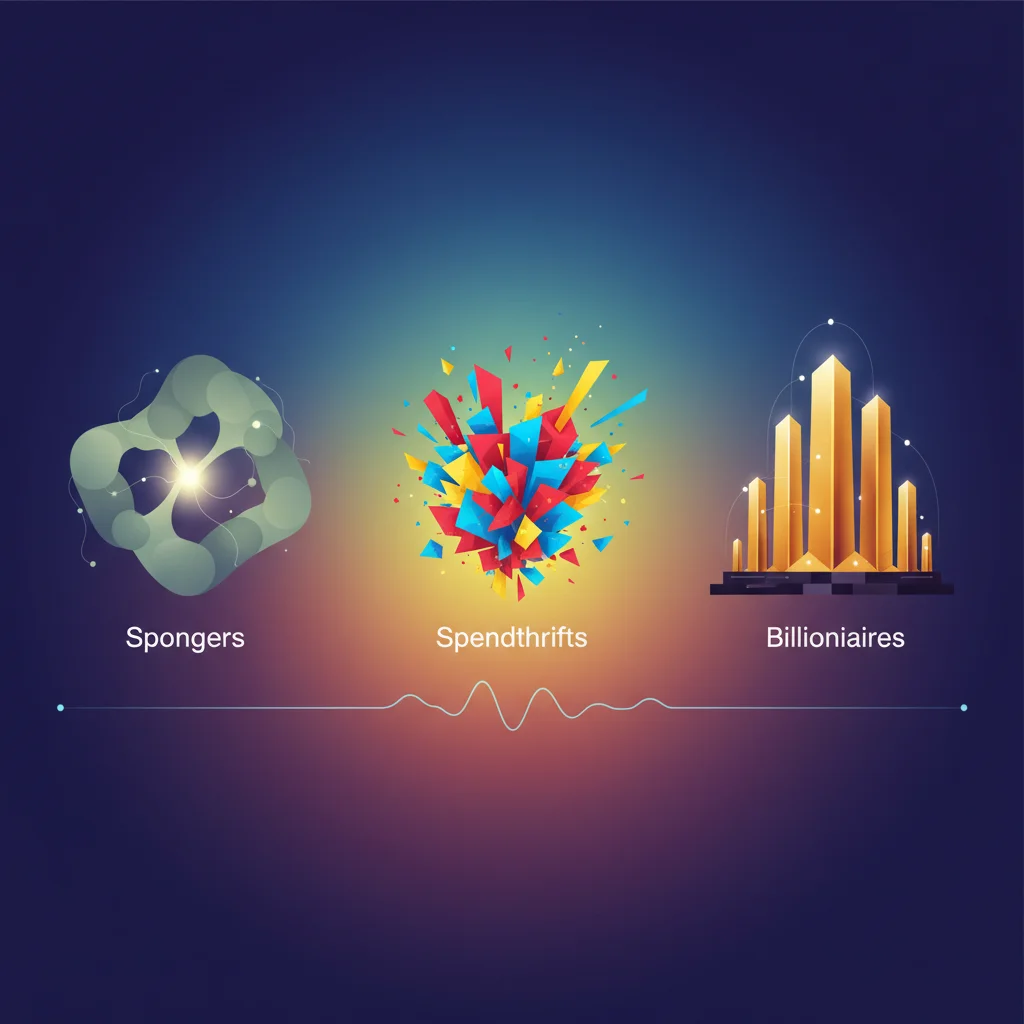
Economic Archetypes: What Spongers, Spendthrifts, and Billionaires Reveal About Our Financial World
The Characters That Define Our Economy
When you watch a show like HBO’s Succession, you see more than just a dysfunctional family drama. You see a reflection of our times: a world grappling with immense corporate power, dynastic wealth, and the opaque influence of media moguls on our society and our economy. The characters we see on screen and read about in books—from the scheming billionaire to the penniless sponger—are more than just entertainment. They are powerful economic archetypes, cultural barometers that reveal the deepest anxieties, aspirations, and structural realities of a financial era.
These recurring character types are, as one insightful analysis from the Financial Times suggests, a lens through which we can understand the evolution of finance, wealth, and societal values. By examining three timeless figures—the Sponger, the Spendthrift, and the Billionaire—we can decode the economic story of our past and gain a clearer perspective on the future of investing, banking, and wealth in the 21st century.
1. The Sponger: A Mirror to Social Contracts and Dependency
Long before modern debates about social safety nets, ancient societies had the “sponger.” In ancient Greece, he was the kolax, the flatterer who secured his meals by pandering to the wealthy. In Rome, he was the parasitus, a stock character in comedies who lived entirely off the patronage of a rich host. This archetype isn’t born from laziness alone; it thrives in specific economic systems. It points to a society built on patronage, where social and financial survival depends not on a formal job but on personal relationships with the powerful.
The existence of the sponger archetype highlights a fundamental tension in any economy: the line between communal support and perceived dependency. In the modern era, this character has evolved. The debate is no longer about flattering a patron for a dinner invitation but about the structure of the welfare state, the sustainability of social security, and the psychological impact of dependency. The modern “sponger” narrative often emerges during periods of economic stress, fueling political debates about who is “deserving” of support and who is “gaming the system.”
This character forces us to ask critical questions about our economic structure. Is our system creating genuine opportunity, or is it fostering dependency? As we explore concepts like Universal Basic Income (UBI), powered by new financial technology, we are actively redesigning the patronage systems of the future. The debate around the “sponger” is, at its core, a debate about the design of our social and economic contract.
Below is a comparison of how this archetype has manifested across different economic eras:
| Characteristic | Ancient Manifestation (The Parasitus) | Modern Manifestation (The “System-Gamer”) |
|---|---|---|
| Source of Sustenance | Direct patronage from a wealthy individual | State-funded social programs or complex loopholes |
| Economic Context | Patron-client society with high inequality | Complex welfare states, gig economy, digital platforms |
| Core Social Anxiety | Flattery, loss of dignity, social obligation | Bureaucracy, dependency, economic stagnation |
Claim Denied: Behind the UK's Insurance Crisis and the Fintech Revolution on the Horizon
2. The Spendthrift: A Cautionary Tale of “Old Money” and New Debt
If the sponger represents a lack of resources, the spendthrift represents the anxiety of squandering them. This is the profligate heir, the character who burns through a generational fortune with reckless abandon. This archetype was particularly prominent in 18th and 19th-century literature, a period of massive economic transition in Europe. As the land-based wealth of the aristocracy gave way to the new, dynamic capital of merchants and industrialists, the spendthrift became a symbol of the old guard’s inability to adapt.
This character’s story is deeply intertwined with the evolution of modern finance and banking. The spendthrift’s downfall is often accelerated by access to credit—loans secured against a dwindling inheritance. His tale is a warning about the dangers of debt and the difference between asset wealth and actual liquidity. He embodies the painful lesson that wealth is not permanent; it must be managed, invested, and grown. According to historians, the fear of the spendthrift reflected a real societal concern as established families lost their footing to a rising commercial class (source).
Today, the spendthrift archetype is more democratic. It’s not just about aristocratic heirs but about anyone in a world of easy credit. The modern spendthrift is the individual drowning in credit card debt, the lottery winner who is bankrupt in five years, or the day trader who gambles their life savings on a meme stock. The core anxiety remains the same: the terrifying speed at which wealth can evaporate without discipline and financial literacy. This archetype serves as a perpetual reminder of the importance of sound principles in personal finance and investing.
3. The Billionaire: From Heroic Industrialist to Global Manipulator
Perhaps no archetype is more central to our current economic discourse than the billionaire. This figure, a product of industrial and post-industrial capitalism, represents a concentration of wealth and power so vast it can shape nations and dictate the trajectory of the stock market. But the portrayal of the billionaire has undergone a dramatic transformation, revealing our shifting attitudes towards capitalism itself.
In the mid-20th century, figures like Ayn Rand’s heroes presented the industrialist as a creative genius, a titan whose ambition drove progress for all. This was the billionaire as a heroic figure. Today, the dominant portrayal is far more cynical and complex. Characters like Logan Roy or Bobby Axelrod from Billions are depicted as brilliant but deeply flawed, often morally compromised figures who manipulate markets, people, and political systems for personal gain. This shift reflects a growing public skepticism about wealth inequality and the ethics of modern capitalism (source).
The modern billionaire archetype forces us to confront uncomfortable questions. Is extreme wealth a product of innovation and value creation, or is it a result of exploitation and systemic advantages? What is the role of these individuals in a democracy? Their stories, whether real or fictional, dominate our financial news and influence our perceptions of the entire economic system, from Main Street to Wall Street.
The evolution of this archetype in popular culture tracks closely with public sentiment on wealth and power:
| Era | Archetype | Example(s) | Economic Undercurrent |
|---|---|---|---|
| Mid-20th Century | The Heroic Industrialist | John Galt (Atlas Shrugged) | Belief in industrial capitalism, innovation as a pure good |
| Late 20th Century | The Corporate Raider | Gordon Gekko (Wall Street) | Anxiety over hostile takeovers, “greed is good” ethos |
| 21st Century | The Tech Visionary / Media Mogul | Logan Roy (Succession), Mark Zuckerberg (The Social Network) | Skepticism of Big Tech, wealth inequality, corporate influence |
The Million-Dollar Mistake: Why Deferring Your Pension Is a Bet Against Your Future Self
What Comes Next? The New Archetypes of the Digital Economy
As our economy continues to be reshaped by technology, new archetypes are inevitably emerging. The sponger, spendthrift, and billionaire will remain, but they will be joined by new characters born from the worlds of fintech, decentralization, and artificial intelligence. We can already see their outlines:
- The Fintech Disruptor: The brilliant but arrogant coder who challenges the entire banking establishment, promising to “democratize finance” while accumulating immense power and wealth themselves.
- The Decentralized Zealot: The blockchain evangelist who lives outside the traditional financial system, navigating a volatile world of crypto assets and DAOs, embodying both radical freedom and extreme risk.
- The Algorithmic Trader: A character who isn’t even human, but an AI that makes billions in the stock market, forcing us to question the nature of intelligence, value, and control in our financial systems.
These emerging figures represent the new frontiers of our economic anxieties and hopes. They are the characters who will define the financial narratives of the coming decades.
A Green Giant Stumbles: Why Vestas' Polish Pause Signals a Storm for European Wind Energy
Culture as an Economic Indicator
The characters that populate our stories are not mere distractions; they are data points. They are reflections of the prevailing economic winds, the societal tensions, and the structural realities that govern our lives. For investors, finance professionals, and business leaders, paying attention to these cultural signals is not a frivolous exercise. It’s a way to understand the deep-seated beliefs and fears that drive consumer behavior, political movements, and market sentiment.
From the ancient Roman parasite to the 21st-century tech mogul, these economic archetypes tell a timeless story about humanity’s relationship with money, power, and status. By learning to read these characters, we can gain a richer, more nuanced understanding of the complex economics at play—not just in our portfolios, but in the world around us.


